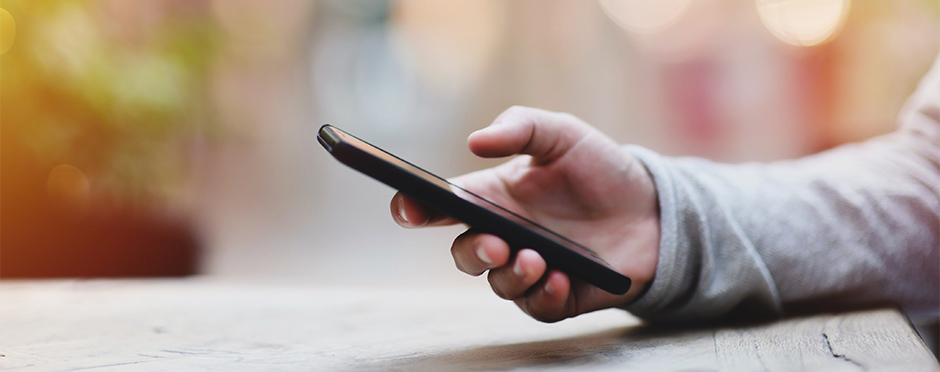
What is Tech Thumb?
Leave a CommentThe average American spends more than four hours on their mobile devices texting, checking email, playing games and browsing social media. In addition, many spend a large portion of the work day typing and mousing on the computer.1,2 The trouble with the amount of time spent on these devices is that they are not ergonomically designed for heavy, repetitive use. Unfortunately, many people don’t become aware of this until they experience pain in their hands and thumbs.
The term used to describe the pain, soreness and discomfort that occurs after heavy electronics use is “tech thumb” or “texting thumb.” While this is not an official diagnosis it is often used to describe the phenomenon of pain associated with electronic device over usage, most often smartphones, gaming consoles, and extended typing and texting. This phenomenon is typically the result of fatigue, tightness and decreased motion in the thumb, which can be signs of a repetitive stress injury or arthritis.
What’s the difference between a repetitive stress injury and arthritis?
A repetitive stress injury or repetitive strain injury (RSI) occurs when consistent overuse of a muscle or tendon results in inflammation in and around the area. This can lead to the occurrence of tendonitis, Carpal Tunnel syndrome, and DeQuervain’s tenosynovitis.
Arthritis in the thumb can occur at the base of the thumb by the wrist, as well as the middle and end joints of the thumb that allow the thumb to bend. Pain, stiffness and swelling are the typical signs of an arthritic thumb.
How do I prevent tech thumb?
While tech thumb can lead to an RSI injury or arthritis, there are ways to combat and decrease the occurrence of pain and decrease the inflammatory processes which can lead to these conditions.
First, take a break. Literally. Put your phone down, step away from the computer, log your hands off from electronics for a few moments. Taking breaks throughout the day can help your hands and thumbs maintain the level of endurance needed to text, type, and manipulate the various screens, keys, and buttons on our devices. Taking breaks also allows the body time to repair muscles, circulate fluid and reduce some of the irritation repetitive use can cause.
Second, perform stretches for your thumbs and hands. Here are three easy stretches you can do throughout the day:
- Thumbs-up: Give yourself a thumbs-up. Stretch your thumbs upward into a thumbs-up position 10 times to help stretch the muscles and tendons of your thumb. This will help by stretching your thumb in the opposite direction of heavy use while texting or using a console.
- Holding a ball: Open your hands wide as if you are holding a basketball. Stretch your thumb and fingers out wide so it looks like they are holding a medium sized ball 10 times to regain mobility in the thumb and fingers. This will help make sure your hand and thumb remain mobile throughout their range of motion.
- Wrist circles: Rotate your wrists clockwise and counterclockwise. Making gentle circles with your wrists allows for much needed movement and stretching of tendons and tissue which helps to stabilize your wrist and hand while using electronic devices.
- Nodding your fist: First, hold your arm out straight and make a gentle fist. Now, with your arm in front of you, nod your first up and down, then side to side 10 times. The yes and no motion of this movement help to stretch muscles and tendons in the forearm, wrist, and hand to maintain motion and decreased inflammation.
Take a Tech Break
The important thing to remember is you can take steps to prevent a lot of tech thumb symptoms starting with taking a break and stretching. However, if you are still having symptoms or have additional concerns you can schedule a free assessment with an Occupational Therapist at one of our Athletico locations.
The Athletico blog is an educational resource written by Athletico employees. Athletico bloggers are licensed professionals who abide by the code of ethics outlined by their respective professional associations. The content published in blog posts represents the opinion of the individual author based on their expertise and experience. The content provided in this blog is for informational purposes only, does not constitute medical advice and should not be relied on for making personal health decisions.
References:
1. “EMarketer.” US Mobile Usage: Top 5 Stats to Know, www.emarketer.com/corporate/coverage/be-prepared-mobile.
2. “How Much Time Do People Spend on Their Mobile Phones in 2017?” Hacker Noon, Hacker Noon, 9 May 2017, hackernoon.com/how-much-time-do-people-spend-on-their-mobile-phones-in-2017-e5f90a0b10a6.
